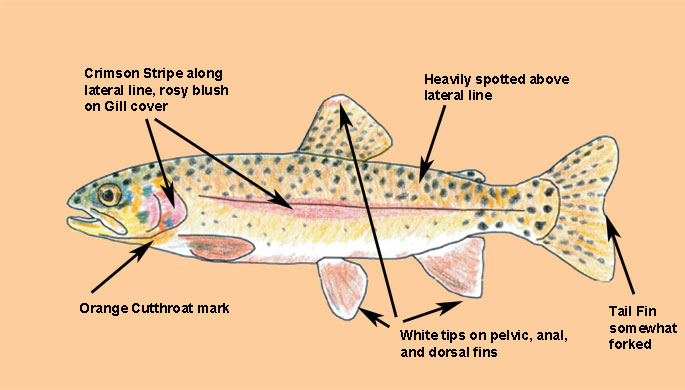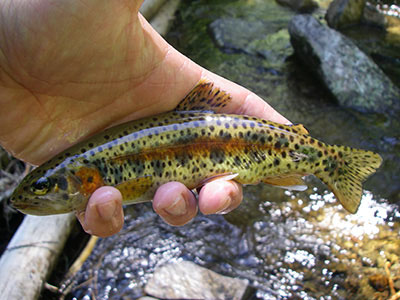McCloud River Redband Trout – discover the world

 | |||
The McCloud River Redband trout (Oncorhyncus mykiss stonei), have been found within tributaries to the McCloud River such as Sheepheaven, Tate, Edson, and Moosehead creeks and from the McCloud River above Middle Falls. Redband trout from Sheepheaven Creek were transplanted into Swamp Creek in 1972 and 1974 and into Trout Creek in 1977, both east of Mt. Shasta. They are now established in those streams. The Goose Lake Redband(Oncorhynchus mykiss gairdneri), occurs in the Goose Lake and Warner Lakes basin. The Redbands are an ancient subspecies of the Rainbow Trout. During the last Pleistocene glaciation (40,000 years ago) the glaciers melted leaving huge lakes. As these lakes receded, the subspecies of Rainbows were isolated. The Redbands and the Goldens are considered the most ancient of the Rainbows, Oncorhyncus mykiss subspecies as the origin of the Rainbow is thought to be near the Gulf of California. The two subspecies are considered at moderate risk with the Calif. DFG’s Heritage Trout Program. The McCloud River Redband (Oncorhyncus mykiss stonei), have been declining in numbers due to hybridization with introduced Rainbow Trout. In addition, there has been increased competition on this habitat by German Browns. The Goose Lake Redband (Oncorhynchus mykiss gairdneri) was petitioned for listing as an endangered species. However, this petition was declined with promises from local landowners that habitat restoration will continue and that the numbers of existing Redband Trout do not warrant listing as “endangered”. Distributed throughout the WorldThe McCloud Rainbows have been touted for many years as the primary rainbow that was distributed to hatcheries and fisheries throughout the United States and other countries. The McCloud Rainbow is also referred to as the Shasta Rainbow. According to Robert Behnke, professor emeritus of Fisheries at Colorado State University, the brood stock that was procured by the U.S. Fish Commission in 1880 were primarily Coastal Rainbows (Steelhead) that inhabited the McCloud River with some McCloud River Redbands mixed-in. The resulting eggs that were shipped from this brood stock for the next fifty years were mostly of Coastal Rainbow genes with some McCloud Redband genes mixed-in. Behnke also points out that not all Coastal Rainbows will return to the ocean but some will remain within it’s resident stream, as may have been the case with the McCloud strain. One of the major attributes of the “McCloud Rainbows” was the ability to remain within the waters that they were introduced. This can be also explained by the fact that steelhead strains also tend to remain within the resident streams when they are introduced into areas outside their native waters. It has been evident that the McCloud Rainbows have been a successful introduction of rainbows throughout the world. However, much of this success can be attributable to the Coastal Rainbow (Steelhead) that were developed within the McCloud drainage. It is difficult to say how those attributes have changed over time with continued introduction of hatchery trout and the loss of genetic diversification by the damming of the McCloud drainage with the Shasta Dam. Distinguishing Characteristics:The Goose Lake Redband has large spots and elliptical parr marks, the body has yellow and orange tints with light colored tips on the fins. The McCloud River Redband (Oncorhyncus mykiss stonei), is similar to the Goose Lake Redband but with some characteristics related to the Coastal Rainbow Trout such as the prominent rose-red lateral line. It is heavily spotted above the lateral line with only a few spots below it. An orange cutthroat mark can be seen below the gill plate. The tail fin has a moderate fork and there are white tips on the pelvic and anal fins. Note a small white and orange tip on the dorsal fin. | |||

